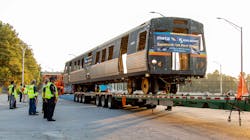MARTA ships off first of two railcars headed toward Atlantic Ocean
The Metropolitan Atlanta Rapid Transit Authority (MARTA) has shipped off the first of two railcars bound for the Georgia coast and eventually the Atlantic Ocean.
MARTA is partnering with the Georgia Department of Natural Resources (DNR) Reef Project to contribute railcars from MARTA’s original fleet as they are replaced by the new CQ400 railcars in coming years. The Reef Project deploys large objects to the bottom of the ocean that over time develop into reef habitats for marine wildlife.
Two older model railcars have been stripped of hazardous materials and contaminants. The dismantled railcars were then inspected and approved by the U.S. Coast Guard for deployment as artificial reef material. The first of the two railcars was loaded onto a truck at MARTA’s South Yard and will be delivered to the East Coast Terminal in Savannah Sept. 8. The second will be picked up Sept. 11 and delivered on Sept. 12.
“MARTA is thrilled to partner with DNR and be part of the Reef Project,” said MARTA Director of Sustainability Richard Thomas. “Reefing is the most affordable and environmentally responsible way to reuse retired railcars and we hope to provide more railcars in the future as we make room for the new trains.”
Once on the coast and when conditions are optimal, the railcars will be deployed by barge to Artificial Reef L, an established reef about two square miles in size, located approximately 23 nautical miles east of Ossabaw Island in about 55 to 65 feet of water.
Over time, the railcars will provide essential marine habitat for sea creatures, including popular sport fish and endangered sea turtles. While the substrate for the reef is manmade, the organisms that will grow on it are entirely natural and beneficial for the environment. Fish and other marine life such as sea turtles are likely to investigate the new habitat almost immediately. Corals, sponges and other encrusting organisms will begin to take hold on the railcars in about one year and will continue to grow and improve the longer they are in the ocean. SCUBA divers and anglers can begin using the reef immediately.
The railcars will join previously deployed materials, including U.S. Army M-60 battle tanks, barges, tugboats, New York City subway cars and other manmade structures. Artificial Reef L was first created in 1976 as part of a network of 32 offshore reefs that the Coastal Resources Division has been building for about 60 years, with an estimated 3 million square feet of reef created as of 2022.
